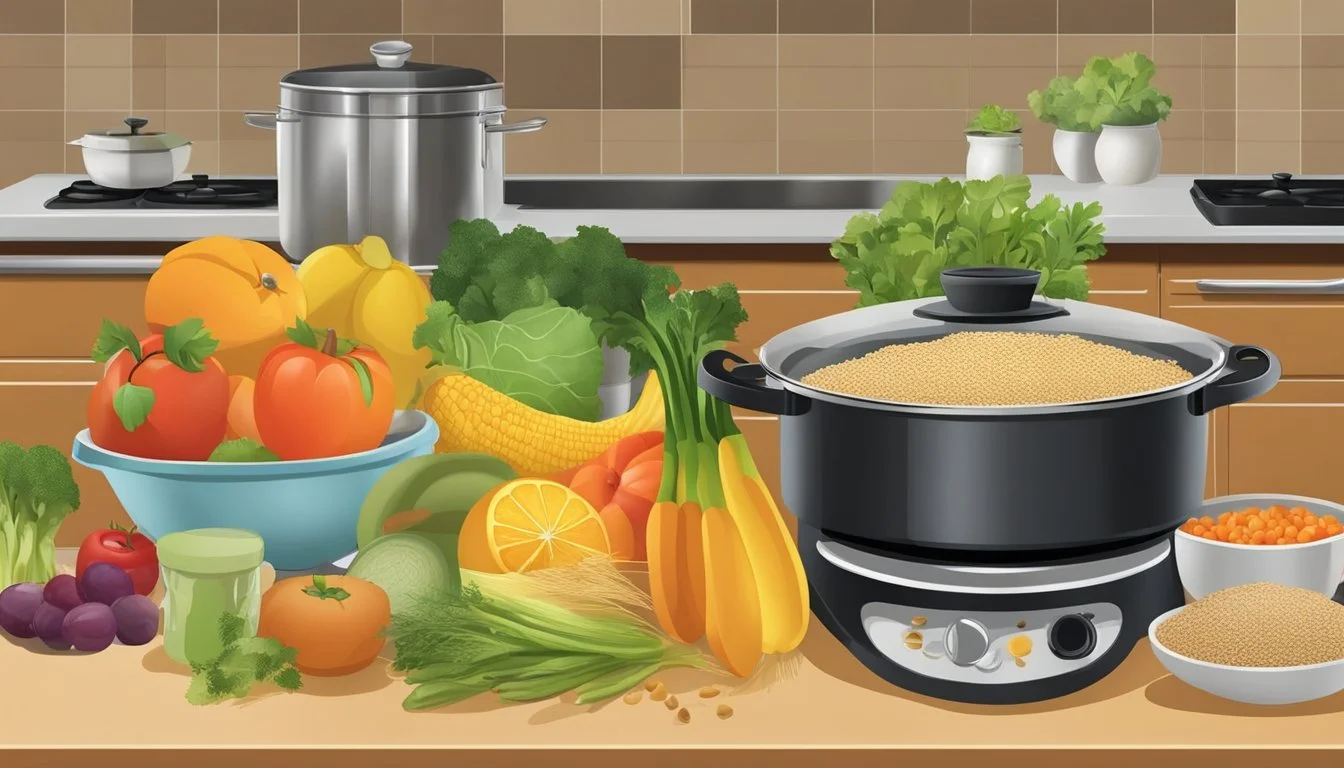How to Cook When You're Battling Depression
Simple Strategies for Healthy Meals
Cooking can often feel like an insurmountable challenge for individuals grappling with depression. The mental health condition can diminish one's energy, motivation, and even the pleasure derived from activities once enjoyed, such as preparing and eating meals. However, engaging in cooking can be therapeutic and provide a sense of accomplishment. It's essential to acknowledge the hurdles that depression may present in the kitchen and find strategies to alleviate the burden, making cooking a more accessible and less daunting task.
One practical approach is to simplify the cooking process. This can involve preparing meals ahead of time on days when energy levels are higher and storing them for later use. Opting for nutritious yet straightforward recipes that require minimal effort and ingredients can also help someone maintain a balanced diet even when their mental health makes cooking feel overwhelming. Incorporating techniques that minimize meal preparation time, such as using pre-cooked rice (how long does cooked rice last?) or pre-cut vegetables, can further reduce the strain of cooking while battling depression.
It is also important to recognize small victories in the kitchen, using them as stepping stones towards regaining confidence and control. Small steps, like assembling ingredients for a simple dish or succeeding in making a comforting meal, can have a positive impact on a person's mood and outlook. By adjusting the cooking process to accommodate the challenges posed by depression, individuals can nurture both their bodies and their mental well-being.
Understanding Depression and Nutrition
Depression can alter eating habits, causing a decreased appetite and subsequent nutrient deficiencies, or it may increase cravings for less nutritious foods. Nutrition plays a significant role in managing depression; particular foods and nutrients are essential for maintaining energy levels and overall mental health.
Nutrients and Mental Health:
Depression's symptoms often include fatigue and low energy. This is where a balanced diet, rich in vitamins, minerals, and amino acids, becomes important. Key components such as B vitamins, magnesium, iron, and selenium are critical for energy and cognitive function.
Healthy Fats and Depression:
Healthy fats, particularly omega-3 fatty acids, found in fish like salmon, (What wine goes well with salmon?) are linked to brain health. They not only contribute to the structure of brain cells but also modulate the production of neurotransmitters, such as serotonin, which regulates mood.
Protein and Amino Acids:
Proteins provide essential amino acids, the building blocks for neurotransmitters. Including a source of protein in each meal can help maintain stable serotonin levels, potentially alleviating some depressive symptoms.
Vitamin D and Mood Regulation:
Vitamin D is noted for its role in mood regulation. Low levels are associated with depressive symptoms. Fortified foods and sunlight exposure can help maintain adequate levels.
Antioxidants and Inflammation:
Foods high in antioxidants can combat oxidative stress and inflammation, which are linked to depression. Including a variety of fruits and vegetables in the diet provides these beneficial compounds.
Nutrient Sources Omega-3 Fatty Acids Salmon, walnuts, flaxseed B Vitamins Leafy greens, whole grains, meat, eggs, beans Iron Red meat, beans, leafy greens, fortified cereals Magnesium Nuts, seeds, whole grains, dark chocolate Selenium Brazil nuts, seafood, meats, whole grains
In summary, incorporating a range of healthy foods into a diet can help manage symptoms of depression by providing necessary nutrients and energy, potentially mitigating fatigue and improving mental health.
Setting Up for Success in the Kitchen
When battling depression, the energy and motivation to cook can be scarce. Setting up one's kitchen for success may reduce the mental load and help make the process of preparing food less daunting. By organizing the space, stocking up on essentials, and engaging in thoughtful meal planning and prep, individuals can create a more manageable and less stressful cooking environment.
Organizing Your Kitchen
Organization is key to creating an inviting kitchen space. Individuals should start by decluttering countertops and ensuring that frequently used items are within easy reach. Grouping similar items together—such as pots and pans, utensils, and spices—can make the process of finding what one needs more straightforward and efficient. For instance, keeping a designated area for baking sheets and pans by dimension and type can help someone effortlessly find what they need without the added stress of searching.
Stocking Up on Essentials
Maintaining a well-stocked pantry and refrigerator ensures that making meals is less of a chore. Staple food items such as rice, pasta, canned goods, and fresh produce should be on hand to facilitate quick and easy meal ideas. As for non-food items, it's beneficial to have an ample supply of foil, plastic wrap, and storage containers to keep leftovers fresh. Individuals should make a concise grocery shopping list that aligns with their energy levels and appetite, aiming to include versatile ingredients that can be used in multiple dishes.
Meal Planning and Prep
Advance meal planning and preparation can significantly reduce the daily burden of cooking. They can start by deciding on a few simple meals for the week and prepping parts of those meals—like chopping vegetables, marinating proteins, or pre-cooking grains—when their energy allows. For instance, one might prepare a large batch of a versatile ingredient like quinoa, which can serve as the base for different meals throughout the week, varied by the addition of fresh vegetables, proteins, or sauces.
By addressing these aspects—organizing the kitchen, stocking up on essentials, and meal planning and prep—one can create a smoother and more positive cooking experience, even while dealing with the challenges of depression.
Simple and Nutritious Meal Ideas
Meal planning during a depressive episode can be simplified by choosing easy-to-prepare and nutritious options. The focus here is on foods known to support mood and energy levels, alongside practical recipes for breakfast, lunch, and dinner.
Mood-Boosting Breakfasts
Smoothies: A blend of banana, berries, spinach, and milk or a dairy-free alternative can be a quick and nutritious start to the day, packed with vitamins and a mood-boosting mix of nutrients.
Oatmeal: A warm bowl of oatmeal topped with walnuts, honey, and sliced strawberries provides complex carbohydrates and omega-3 fatty acids for sustained energy.
Lunch Solutions
Salads: Combine leafy greens like kale with avocado, nuts or seeds, chopped fruit, and a dressing made with olive oil for a lunch that's as heart-healthy as it is mood-lifting.
Wraps: Filling a whole grain wrap with hummus, couscous or quinoa, and roasted vegetables offers a balance of protein, fiber, and essential nutrients.
Healing Dinners
Salmon and Vegetables: Grilled or baked salmon with a side of steamed broccoli and sweet potatoes gives a dose of omega-3s and antioxidants.
Stir-fry: A quick stir-fry with lean proteins like chicken or tofu, brown rice, and a variety of vegetables like bell peppers, snow peas, and carrots is both comforting and beneficial for overall health.
Quick Fixes for Low-Energy Days
On days when energy is low and cooking feels like a chore, simple meal preparations can make a significant difference. Snacks and light meals that require minimal preparation help maintain energy levels without being overwhelming, while make-ahead options ensure there are nourishing meals that can be heated quickly.
Energizing Snacks and Light Meals
Simple snacks can be both satisfying and energizing. A straightforward approach is to spread nut butter on whole-grain toast, adding a sprinkle of chia seeds or flax seeds for extra nutrients. For something more substantial, one might consider an avocado toast with feta cheese and fresh herbs, which combines healthy fats and protein.
Smoothies are also a quick solution, blending together a mix of fruits, a handful of greens, and a spoonful of seeds or nut butter.
Snacking on a bowl of rice or pasta with a dash of butter and salt, or mixing in canned beans with a drizzle of olive oil provides a more filling option.
A stir-fry using leftover veggies and a protein source can be assembled quickly with ready-to-use sauces.
Make-Ahead Options
For those who experience days where cooking feels impossible, having meals prepared ahead of time can be a lifeline. Soups, stews, and casseroles made in an instant pot or slow cooker are ideal make-ahead meals. These can be frozen in individual portions and easily reheated.
Soup made with broth, vegetables, and beans can be prepared in large quantities and consumed over several days.
Pasta dishes like lasagna also freeze well and can be portioned for future use.
Preparing a large amount of rice or pasta at the start of the week allows for quick meals later on, like fried rice with veggies and an egg.
Using an instant pot can drastically reduce cooking time for foods that typically take longer to prepare, such as stews full of legumes and root vegetables. They can prepare meals fast without supervision, freeing up the individual's time and energy.
With efficient meal planning and simple cooking techniques, those experiencing depression can enjoy nutritious meals even on their lowest energy days.
Nutrient-Rich Foods to Fight Depression
Depression can impact one's life significantly, and while diet alone isn't a cure, certain foods are known to help improve symptoms. A combination of vitamins, minerals, amino acids, and omega-3 fatty acids play a role in maintaining mental health.
Leafy Greens: Rich in fiber, iron, and magnesium, these vegetables support brain function and are crucial for the synthesis of serotonin, a neurotransmitter associated with mood regulation.
Fatty Fish: Salmon and similar fish provide omega-3 fatty acids, which have been linked to reduced depression symptoms due to their anti-inflammatory properties.
Nuts and Seeds: Particularly walnuts and flaxseeds, they're another source of beneficial omega-3 fats.
Whole Grains: These foods are high in fiber, aiding in digestion and providing a steady release of energy, which can combat fatigue associated with depression.
Berries: Their antioxidant properties can help reduce inflammation and cognitive decline.
Lean Proteins: Turkey, chicken, and eggs supply amino acids which are the building blocks for neurotransmitters like serotonin.
Legumes: Beans and lentils contain B vitamins and iron that can help improve mood by supporting brain health.
Focusing on these nutrient-dense foods not only supports overall health but may provide a much-needed mood boost.
Food Group Key Nutrients Example Foods Fruits Vitamins, Fiber Berries, Avocado Vegetables Magnesium, Iron, Vitamins Leafy greens, Tomatoes Protein Omega-3, Amino Acids Fatty fish, Turkey, Eggs Nuts/Seeds Omega-3, Vitamins Walnuts, Flaxseeds Whole Grains Fiber, B Vitamins Brown rice, Quinoa Legumes Fiber, Iron, B Vitamins Beans, Lentils
By incorporating these foods into one's diet, individuals may notice an improvement in their mental health and an alleviation of depression symptoms.
Staying Motivated to Cook
One's mental health, particularly when managing depression, can significantly influence their motivation and energy levels for daily tasks, including cooking. Establishing a routine can be a cornerstone for staying motivated. A well-thought-out plan helps individuals allocate their energy effectively and ensures they have the necessary ingredients on hand. Simple, nourishing foods should be at the core of this plan, focusing on minimal preparation but maximizing nutritional value.
Individuals should consider preparing meals in advance during periods when their energy and appetite may be higher. Bulk cooking and freezing meals can alleviate the pressure to cook daily. This strategy can be particularly helpful for those days when even small tasks feel overwhelming.
Here are a few actionable tips to help maintain cooking motivation:
Create a Cooking Schedule:
Plan easy meals for the week, and set specific times for cooking. Clear plans can reduce decision fatigue.Prep Ingredients in Advance:
Wash and cut vegetables, or measure out portions ahead of time. This can make the actual cooking process smoother and faster.Focus on Simple Recipes:
Choose dishes that require fewer steps and use common pantry items. One-pot meals are excellent for reducing both effort and cleanup.Enlist Support:
If possible, ask friends or family to help with meal prep or to cook together. This can provide social interaction and lighten the load.
By incorporating these techniques into one’s routine, individuals can help ensure that their nutritional needs are met, which is crucial for managing depression. Maintaining a balanced diet contributes to overall wellbeing and can be a positive step towards improved mental health.
How to Cope with Cooking and Depression
When an individual is grappling with depression, the task of cooking can feel overwhelming. However, with some strategic approaches, they can navigate this challenge and maintain a nutritious diet, which is essential for mental health management.
Meal Preparation Strategies:
Prep on Good Days: On days when they feel more capable, it's beneficial to prepare multiple meals and freeze them for harder days.
Simplified Recipes: Opt for recipes that require minimal effort, such as microwave "baked" potatoes or scrambled eggs.
Healthy Convenience Foods: Keep a stash of nutritious, low-preparation foods like pre-washed vegetables, nuts, or whole-grain breads.
Energy-Adaptive Cooking:
Energy Level Preparatory Steps High Batch cook and store for later. Moderate Assemble simple, fresh meals. Low Utilize pre-prepped or frozen meals.
Individuals should be encouraged to listen to their bodies and choose cooking activities that match their current energy levels.
Ingredient Management:
Stock Essentials: Keep a pantry stocked with staples like rice, pasta, or canned beans that are versatile and easy to prepare.
Use Flavor Enhancers: Items like lemons, vinegars, or broths can add flavor to meals without significant added effort.
In managing both cooking and depression, the individual's focus should be on self-kindness and feasible adjustments that allow them to nourish themselves without exacerbating their condition. Small actions in the kitchen can lead to significant benefits for mental wellness.
When Cooking Feels Impossible
Depression can sap a person's energy, making even simple tasks like cooking feel daunting. This section provides practical tips for days when preparing a meal is a struggle, as well as the significance of professional help in managing these challenges.
Alternative Options When You Can't Cook
When an individual is unable to cook, exploring alternative dining options can help maintain nutrition until their energy and mood improve. Consider the simplicity of takeout or food delivery services; these options can provide a diverse range of dishes that cater to different tastes and dietary needs. On days when selecting and ordering food feels overwhelming, one can turn to pre-prepared meals or nutritious snacks that require minimal to no preparation, such as:
Pre-cooked rice or quinoa
Canned tuna or chicken
Pre-cut vegetables or fruits
Yogurt or cheese sticks
Hard-boiled eggs
Seeking Professional Help
Managing one's appetite and dietary habits during depressive episodes is critical, yet it's often helpful to couple these strategies with appropriate treatments for depression. A healthcare provider can offer avenues such as medication or therapy to support overall well-being and ease the burden of daily tasks. It's important to communicate openly with healthcare professionals, as they can tailor treatment plans to accommodate an individual's specific needs, potentially alleviating the intensity of depressive symptoms and facilitating a smoother pathway to recovery.








